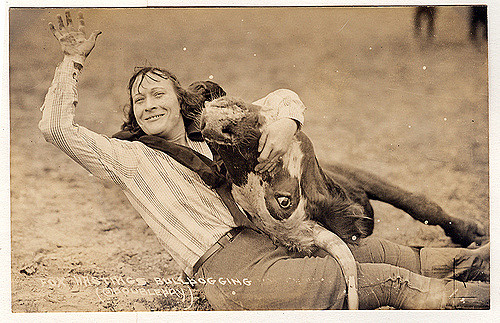

What’s the weirdest thing you learned this week? Well, whatever it is, we promise you’ll have an even weirder answer if you listen to PopSci’s hit podcast. The Weirdest Thing I Learned This Week hits iTunes, Anchor, and everywhere else you listen to podcasts every Wednesday morning. It’s your new favorite source for the strangest science-adjacent facts, figures, and Wikipedia spirals the editors of Popular Science can muster. If you like the stories in this post, we guarantee you’ll love the show.
Fact: This man bit bulls by the lip
By Eleanor Cummins
Don’t mess with Texas…’s native son Bill Pickett. The legendary cow-puncher, who lived from 1870 to 1932, invented his own rodeo event. Today it’s called steer wrestling and involves leaping off your horse mid-charge, grabbing hold of a steer, and wrenching its horn until it’s forced to lay down in the arena dirt (more on that later). But back then this singular sport was known as “bulldogging,” because Pickett’s preferred method for leveling cows was to leap off his horse mid-charge, grab hold of the steer, and then bite it on the lip.
I first learned about bulldogging last Thanksgiving, on a visit to the Texas Bullock State History Museum, which was showing a temporary attraction called “Rodeo! The Exhibit.” There were rhinestones and cowboys, but what really stuck out to me was the incredible blend of cultures that grew into rodeo, from the Spanish colonists to the native cow herders. The contributions of the fearless Mr. Pickett, who was himself the child of recently-emancipated slaves, reflect this vibrant, troublesome, incredible history better than anything else.
Oh—and the dirt. Arena dirt, as I wrote in an article for popsci dot com, can totally make or break a rodeo.
Now giddyup!
Fact: A 30-foot-tall wave of molasses destroyed Boston’s North End in 1919
By Jessica Boddy
In the early 20th century, a hulking, somewhat ominous molasses storage tank loomed over Boston. It was notoriously leaky—local children would often collect stray molasses drippings in a pail and bring the sweet stuff home to their families. And on a warm January day in 1919, disaster finally struck: the tank burst and 2.5 million gallons of warm, sticky molasses escaped, forming a 30-foot wave that traveled at 35 miles per hour. This molasses tsunami flattened buildings, knocked out the steel supports for an elevated train, killed 21 people, and injured more than 100. Many bodies were found during the cleanup, which took months and involved salt water, saws, and industrial-strength brooms. Local Bostonians today say you can still smell molasses on a hot day in the north end, an entire century later.
Fact: This 1911 physician promised a pretty widow the world—or at least a new finger
By Rachel Feltman
Finger transplantation is not something you hear about a lot, and for good reason: it’s not generally necessary and it’s always extremely difficult. The first successful hand transplant didn’t even occur until 1999, which was after two apparent triumphs that ended in tragedy (you can hear more about that in this week’s episode).
But back in 1911—more than a decade before the discovery of antibiotics, not to mention the super-powerful immunosuppressant drugs it takes to keep a body from violently rejecting someone else’s organ or appendage—newspapers started putting out calls for finger donors. A doctor sought to appease a young widow troubled over the loss of her index finger by finding her a new one, and she was willing to pay. He was under the impression that someone could ship the digit over in the mail. This was, to put it lightly, a really whacky idea.
*If you like The Weirdest Thing I Learned This Week, please subscribe, rate, and review us on iTunes (yes, even if you don’t listen to us on iTunes—it really helps other weirdos find the show). You can also join in the weirdness in our Facebook group and bedeck yourself in weirdo merchandise from our Threadless shop.
